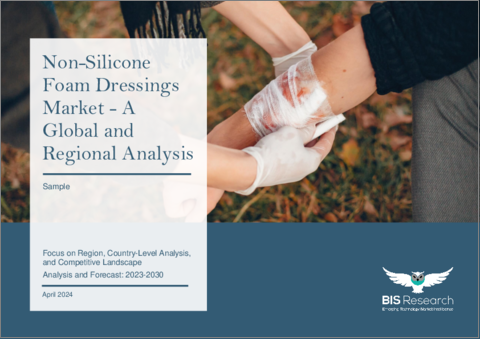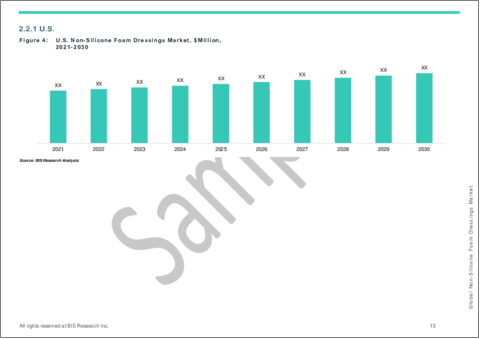|
|
市場調査レポート
商品コード
1488261
非シリコーンフォームドレッシング市場- 世界および地域別分析:地域、国別分析、競合情勢 - 分析と予測(2023年~2030年)Non-Silicone Foam Dressings Market - A Global and Regional Analysis: Focus on Region, Country-Level Analysis, and Competitive Landscape - Analysis and Forecast, 2023-2030 |
||||||
カスタマイズ可能
|
|||||||
| 非シリコーンフォームドレッシング市場- 世界および地域別分析:地域、国別分析、競合情勢 - 分析と予測(2023年~2030年) |
|
出版日: 2024年06月04日
発行: BIS Research
ページ情報: 英文 40 Pages
納期: 1~5営業日
|
全表示
- 概要
- 図表
- 目次
世界の非シリコーンフォームドレッシングの市場規模は、2022年に5億1,310万米ドルとなりました。同市場は堅調な成長軌道にあり、2030年には6億9,970万米ドルに達すると予測されています。この市場は、2023年から2030年にかけてCAGR4.07%で拡大すると予測されています。こうした成長を後押しするのは、慢性創傷の有病率の上昇です。糖尿病や肥満などの慢性疾患の増加は、糖尿病性足部潰瘍や静脈性脚潰瘍のような創傷治癒合併症を頻繁に引き起こすことが多く、非シリコーンフォーム包帯などの効果的な創傷管理製品の需要が高まることが予想されます。より優れた滲出液管理を提供し、湿潤創傷治癒環境を促進する、より高度な非シリコーンフォームドレッシングの開発を含む、創傷ケア製品の革新は、市場の成長を促進すると予想されます。
| 主要市場統計 | |
|---|---|
| 予測期間 | 2023年~2030年 |
| 2023年の評価額 | 5億2,940万米ドル |
| 2030年予測 | 6億9,970万米ドル |
| CAGR | 4.07% |
非シリコーンフォームドレッシング材は、創床に付着することなく滲出液を管理する能力で知られ、慢性創傷の管理や術後ケアで人気が高まっています。これらのドレッシング材は、痛みがなく剥がすことができ、敏感な皮膚にも適合するため、高齢者や糖尿病などの慢性疾患を持つ患者の増加に理想的であるとして、特に好まれています。市場の拡大を支えているのは、創傷ケアの技術的進歩、世界のヘルスケア支出の増加、効果的な創傷管理の利点に対する意識の高まりです。ヘルスケア産業が進化を続ける中、非シリコーンフォームドレッシング材市場は、主要市場プレイヤーの戦略的イニシアチブを原動力に、先進地域と新興国市場の両方で新たなビジネスチャンスを活かすことが期待されます。
当レポートでは、世界の非シリコーンフォームドレッシング市場について調査し、市場の概要とともに、地域別の動向、および市場に参入する企業のプロファイルなどを提供しています。
目次
エグゼクティブサマリー
第1章 市場
- 製品定義
- 包含基準と除外基準
- 主な質問への回答
- 分析と予測ノート
- 主な調査結果
第2章 地域
- 地域別概要
- 北米
- 米国
- カナダ
- 欧州
- ドイツ
- フランス
- イタリア
- 英国
- ロシア連邦
- トルコ
- スペイン
- ベルギー
- オランダ
- ポーランド
- ノルウェー
- デンマーク
- フィンランド
- アイルランド
- スイス
- オーストリア
- チェコ共和国
- ルーマニア
- ウクライナ
- スウェーデン
- ギリシャ
- ポルトガル
- スロバキア
- アジア太平洋
- 中国
- インド
- 日本
- 韓国
- オーストラリア
- マレーシア
- タイ
- ラテンアメリカ
- ブラジル
- メキシコ
- アルゼンチン
- コロンビア
- チリ
- その他の地域
第3章 市場-競合ベンチマーキング
- 主な戦略と開発
- 主要企業エコシステム
第4章 調査手法
List of Figures
- Figure 1: Global Non-Silicone Foam Dressings Market, $Million, 2022, 2026, and 2030
- Figure 2: Global Non-Silicone Foam Dressings Market (by Region), $Million, 2022, 2026, and 2033
- Figure 3: Key Industrial Trends in the Global Non-Silicone Foam Dressings Market
- Figure 4: U.S. Non-Silicone Foam Dressings Market, $Million, 2021-2030
- Figure 5: Canada Non-Silicone Foam Dressings Market, $Million, 2021-2030
- Figure 6: Germany Non-Silicone Foam Dressings Market, $Million, 2021-2030
- Figure 7: France Non-Silicone Foam Dressings Market, $Million, 2021-2030
- Figure 8: Italy Non-Silicone Foam Dressings Market, $Million, 2021-2030
- Figure 9: U.K. Non-Silicone Foam Dressings Market, $Million, 2021-2030
- Figure 10: Russian Federation Non-Silicone Foam Dressings Market, $Million, 2021-2030
- Figure 11: Turkey Non-Silicone Foam Dressings Market, $Million, 2021-2030
- Figure 12: Spain Non-Silicone Foam Dressings Market, $Million, 2021-2030
- Figure 13: Belgium Non-Silicone Foam Dressings Market, $Million, 2021-2030
- Figure 14: Netherlands Non-Silicone Foam Dressings Market, $Million, 2021-2030
- Figure 15: Poland Non-Silicone Foam Dressings Market, $Million, 2021-2030
- Figure 16: Norway Non-Silicone Foam Dressings Market, $Million, 2021-2030
- Figure 17: Denmark Non-Silicone Foam Dressings Market, $Million, 2021-2030
- Figure 18: Finland Non-Silicone Foam Dressings Market, $Million, 2021-2030
- Figure 19: Ireland Non-Silicone Foam Dressings Market, $Million, 2021-2030
- Figure 20: Switzerland Non-Silicone Foam Dressings Market, $Million, 2021-2030
- Figure 21: Austria Non-Silicone Foam Dressings Market, $Million, 2021-2030
- Figure 22: Czech Republic Non-Silicone Foam Dressings Market, $Million, 2021-2030
- Figure 23: Romania Non-Silicone Foam Dressings Market, $Million, 2021-2030
- Figure 24: Ukraine Non-Silicone Foam Dressings Market, $Million, 2021-2030
- Figure 25: Sweden Non-Silicone Foam Dressings Market, $Million, 2021-2030
- Figure 26: Greece Non-Silicone Foam Dressings Market, $Million, 2021-2030
- Figure 27: Portugal Non-Silicone Foam Dressings Market, $Million, 2021-2030
- Figure 28: Slovakia Non-Silicone Foam Dressings Market, $Million, 2021-2030
- Figure 29: China Non-Silicone Foam Dressings Market, $Million, 2021-2030
- Figure 30: India Non-Silicone Foam Dressings Market, $Million, 2021-2030
- Figure 31: Japan Non-Silicone Foam Dressings Market, $Million, 2021-2030
- Figure 32: South Korea Non-Silicone Foam Dressings Market, $Million, 2021-2030
- Figure 33: Australia Non-Silicone Foam Dressings Market, $Million, 2021-2030
- Figure 34: Malaysia Non-Silicone Foam Dressings Market, $Million, 2021-2030
- Figure 35: Thailand Non-Silicone Foam Dressings Market, $Million, 2021-2030
- Figure 36: Brazil Non-Silicone Foam Dressings Market, $Million, 2021-2030
- Figure 37: Mexico Non-Silicone Foam Dressings Market, $Million, 2021-2030
- Figure 38: Argentina Non-Silicone Foam Dressings Market, $Million, 2021-2030
- Figure 39: Colombia Non-Silicone Foam Dressings Market, $Million, 2021-2030
- Figure 40: Chile Non-Silicone Foam Dressings Market, $Million, 2021-2030
- Figure 41: Data Triangulation
- Figure 42: Top-Down and Bottom-Up Approach
- Figure 43: Assumptions and Limitations
List of Tables
- Table 1: Market Snapshot
- Table 2: Global Non-Silicone Foam Dressings Market (by Region), $Million, 2021-2030
- Table 3: North America Non-Silicone Foam Dressings Market (by Country), $Million, 2021-2030
- Table 4: Europe Non-Silicone Foam Dressings Market (by Country), $Million, 2021-2030
- Table 5: Asia-Pacific Non-Silicone Foam Dressings Market (by Country), $Million, 2021-2030
- Table 6: Latin America Non-Silicone Foam Dressings Market (by Country), $Million, 2021-2030
- Table 7: Rest-of-the-World Non-Silicone Foam Dressings Market (by Country), $Million, 2021-2030
- Table 8: Key Initiatives, 2021-2024
- Table 9: Key Companies, Global Non-Silicon Foam Dressings Market
Introduction of Non-Silicone Foam Dressings Market
The global non-silicone foam dressings market, valued at $513.1 million in 2022, is on a trajectory of robust growth and is anticipated to reach $699.7 million by 2030. This market is expected to expand at a compound annual growth rate (CAGR) of 4.07% between 2023 and 2030. Such growth is propelled by Increasing Prevalence of Chronic Wounds: The rise in chronic conditions, such as diabetes and obesity, which frequently lead to wound healing complications like diabetic foot ulcers and venous leg ulcers, is expected to drive demand for effective wound management products, including non-silicone foam dressings. Innovations in wound care products, including the development of more advanced non-silicone foam dressings that offer better exudate management and promote a moist wound healing environment, are expected to boost the market grow.
Market Introduction
| KEY MARKET STATISTICS | |
|---|---|
| Forecast Period | 2023 - 2030 |
| 2023 Evaluation | $529.4 Million |
| 2030 Forecast | $699.7 Million |
| CAGR | 4.07% |
Non-silicone foam dressings, known for their ability to manage exudate without adhering to the wound bed, are becoming increasingly popular in managing chronic wounds and post-operative care. These dressings are particularly favoured for their pain-free removal and compatibility with sensitive skin, making them ideal for a patient population that includes a growing number of elderly and individuals with diabetes or other chronic conditions. The market's expansion is supported by technological advancements in wound care, increasing global healthcare expenditure, and a rising awareness of the benefits of effective wound management. As the healthcare industry continues to evolve, the non-silicone foam dressings market is expected to capitalize on emerging opportunities in both developed and developing regions, driven by strategic initiatives from key market players.
Regional Segmentation:
- North America
- U.S.
- Canada
- Europe
- U.K.
- Germany
- France
- Italy
- Spain
- Netherlands
- Switzerland
- Russian Federation
- Turkey
- Poland
- Belgium
- Sweden
- Ireland
- Norway
- Austria
- Denmark
- Finland
- Portugal
- Czech Republic
- Romania
- Greece
- Slovakia
- Ukraine
- Asia-Pacific
- Japan
- China
- India
- South Korea
- Australia
- Malaysia
- Thailand
- Latin America
- Brazil
- Mexico
- Colombia
- Argentina
- Chile
- Rest-of-the-World
The global non-silicone foam dressings market is projected to grow from $513.1 million in 2022 to $699.7 million by 2030, at a CAGR of 4.07%. Regionally, Asia-Pacific maintains the largest market share, demonstrating steady growth with a CAGR of 5.15%, due to the rapid expansion of healthcare infrastructure and increasing public health awareness about effective wound management. Europe follows with a 3.40% CAGR, driven by the rising prevalence of chronic diseases such as diabetes and obesity, which require ongoing management of chronic wounds using non-silicone foam dressings. The North America region shows growth at a 3.45% CAGR, fueled by increasing investments in healthcare technology and a growing elderly population that necessitates more advanced wound care solutions. Latin America and the Rest-of-the-World regions exhibit the highest growth rates at 4.14% and 3.20% CAGRs, respectively, due to improvements in healthcare infrastructure and the increasing adoption of western medical practices, alongside government initiatives aimed at enhancing overall healthcare accessibility and quality.
Recent Developments in the Non-Silicone Foam Dressings Market
- In April 2021, DermaRite Industries, LLC. published a case study of challenging wounds that were effectively treated using an antimicrobial foam dressing. 87% of patients achieved complete wound healing within a period of less than 90 days with the inclusion of DermaBlue+ Foam in their dressing regimen.
How can this report add value to an organization?
Product/Innovation Strategy: The report provides insights into current market trends and future projections which can guide research and development efforts. Understanding specific needs within the market, such as the demand for non-silicone dressings in treating chronic wounds or post-surgical care, can lead to the development of innovative products tailored to meet these needs.
Growth/Marketing Strategy: The report helps identify key demographic segments driving demand, such as the aging population or regions with rising healthcare expenditure. This knowledge enables precise targeting in marketing campaigns and product distribution strategies. Insights into emerging markets and the economic factors affecting them can help companies plan strategic entries into high-growth regions, optimizing their market presence.
Competitive Strategy: Understanding the competitive landscape is crucial. The report provides an overview of key players and their market shares, strategic moves, and product offerings. This information helps companies benchmark their performance against competitors and strategize on differentiating their offerings. Insights into market trends and forecasts can guide strategic decisions regarding mergers, acquisitions, or partnerships. Companies can identify potential partners for collaboration to enhance their market position or expand into new territories.
Methodology
Key Considerations and Assumptions in Market Engineering and Validation
- The base year considered for the calculation of the market size is 2022. A historical year analysis has been done for the period FY2019-FY2021. The market size has been estimated for FY2022 and projected for the period FY2023-FY2030.
- The scope of this report has been carefully derived based on interactions with experts in different companies across the world. This report provides a market study of upstream and downstream products of non-silicone foam dressings.
- The market contribution of non-silicone foam dressings is anticipated to be launched in the future has been calculated based on the historical analysis of the solutions.
- Revenues of the companies have been referenced from their annual reports for FY2022 and FY2023. For private companies, revenues have been estimated based on factors such as inputs obtained from primary research, funding history, market collaborations, and operational history.
- The market has been mapped based on the available non-silicone foam dressings solutions. All the key companies with significant offerings in this field have been considered and profiled in this report.
Primary Research:
The primary sources involve industry experts in non-silicone foam dressings, including the market players offering products and services. Resources such as CEOs, vice presidents, marketing directors, and salespersons have been interviewed to obtain and verify both qualitative and quantitative aspects of this research study.
The key data points taken from the primary sources include:
- Validation and triangulation of all the numbers and graphs
- Validation of the report's segmentation and key qualitative findings
- Understanding the competitive landscape and business model
- Current and proposed production values of a product by market players
- Percentage split of individual markets for regional analysis
Secondary Research
Open Sources
- Certified publications, articles from recognized authors, white papers, directories, and major databases, among others
- Annual reports, SEC filings, and investor presentations of the leading market players
- Company websites and detailed study of their product portfolio
- Gold standard magazines, journals, white papers, press releases, and news articles
- Paid databases
The key data points taken from the secondary sources include:
- Segmentations and percentage shares
- Data for market value
- Key industry trends of the top players of the market
- Qualitative insights into various aspects of the market, key trends, and emerging areas of innovation
- Quantitative data for mathematical and statistical calculations
Key Market Players and Competition Synopsis
In the global non-silicone foam dressings market, the competition within the market is driven by several factors including innovation, product quality, and pricing strategies. Many companies focus on technological advancements to enhance the efficacy of their non-silicone foam dressings, aiming to improve patient outcomes and reduce overall healthcare costs. The market is also characterized by strategic mergers, acquisitions, and partnerships, which are tactics companies use to expand their market share and enter new regional markets.
Some prominent names established in this market are:
- Molnlycke
- Smith & Nephew
- 3M
- Advancis Medical
- Coloplast
- ConvaTec
- Medline Industries
- L&R Group
- Essity
- B. Braun
- DermaRite Industries, LLC.
- Acto GmbH
Table of Contents
Executive Summary
1 Markets
- 1.1 Product Definition
- 1.2 Inclusion and Exclusion Criteria
- 1.2.1 Inclusion
- 1.2.2 Exclusion Criteria
- 1.3 Key Questions Answered
- 1.4 Analysis and Forecast Note
- 1.5 Key Findings
2 Regions
- 2.1 Regional Summary
- 2.2 North America
- 2.2.1 U.S.
- 2.2.2 Canada
- 2.3 Europe
- 2.3.1 Germany
- 2.3.2 France
- 2.3.3 Italy
- 2.3.4 U.K.
- 2.3.5 Russian Federation
- 2.3.6 Turkey
- 2.3.7 Spain
- 2.3.8 Belgium
- 2.3.9 Netherlands
- 2.3.10 Poland
- 2.3.11 Norway
- 2.3.12 Denmark
- 2.3.13 Finland
- 2.3.14 Ireland
- 2.3.15 Switzerland
- 2.3.16 Austria
- 2.3.17 Czech Republic
- 2.3.18 Romania
- 2.3.19 Ukraine
- 2.3.20 Sweden
- 2.3.21 Greece
- 2.3.22 Portugal
- 2.3.23 Slovakia
- 2.4 Asia-Pacific
- 2.4.1 China
- 2.4.2 India
- 2.4.3 Japan
- 2.4.4 South Korea
- 2.4.5 Australia
- 2.4.6 Malaysia
- 2.4.7 Thailand
- 2.5 Latin America
- 2.5.1 Brazil
- 2.5.2 Mexico
- 2.5.3 Argentina
- 2.5.4 Colombia
- 2.5.5 Chile
- 2.6 Rest-of-the-World
3 Markets - Competitive Benchmarking
- 3.1 Key Strategies and Developments
- 3.2 Key Companies Ecosystem
4 Research Methodology
- 4.1 Data Sources
- 4.1.1 Primary Data Sources
- 4.1.2 Secondary Data Sources
- 4.1.3 Data Triangulation
- 4.2 Market Estimation and Forecast





